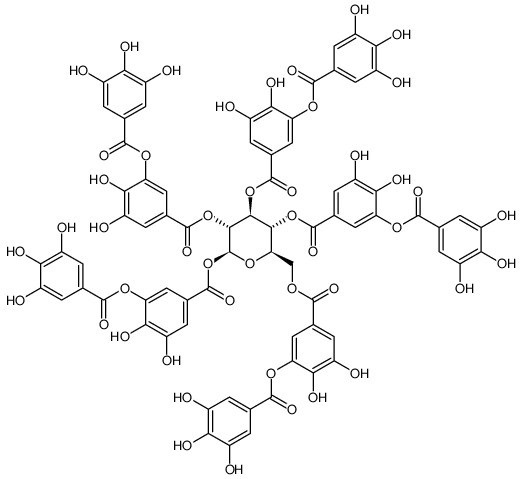| Catalogue number |
C108029 |
| Chemical name | Tannic acid |
| CAS Number | 1401-55-4 |
| Synonyms | Chinese tannin; Gallotannic acid; Gallotannin; Galloylglucose; Glycerite; Quebracho;
Penta NM digalloyl glucose; Tannins; 1,3,6-tris-O-(3,4,5-trihydroxybenzoyl)hexopyranose;
1,2,3,4,6-pentakis-O-[(3,4-dihydroxy-5-{[(3,4,5-trihydroxyphenyl)carbonyl]oxy}phenyl)carbonyl]hexopyranose |
| Molecular Weight | C76H52O46 |
| Formula | 1701.2 |
| Purity | 98% |
| Physical Description | Powder |
| Solvent | Chloroform, Dichloromethane,DMSO |
| Storage | Stored at 2-8°C, Protected from air and light, refrigerate or freeze |
| Applications | The tannic acids were found to show potent inhibitory activity against HIV RT.
Thermally processed tannic acid (PTA) showed stronger antioxidant capacity and antimicrobial activity by Rancimat and disc diffusion tests than fresh tannic acid (FTA).
Soybean oil treated with PTA had 33-84% longer induction period (IP) of oxidation (8.0-14.7 h) than FTA treated oil (6.0-8.0 h), while untreated oil (control) showed only 5.9 h IP. The IP was increased (p < 0.05) with increased processing time up to 15 min, with no changes thereafter. The PTA samples had strong antimicrobial activity (inhibition zone diameter 12 mm) on 10 tested human pathogens while the FTA samples showed antimicrobial activity only on two strains, Salmonella Typhimurium (ATCC 14028) and Enterobacter sakazakii MSDH over 1- and 2-day incubation periods. 13C NMR spectra showed that PTA had a higher content of hydrolysed aromatic carboxylic acid groups than FTA. The results showed that thermally processed tannic acid for 15 min had about 67% higher antioxidant capacity and about 50% higher antimicrobial activity than its fresh counterpart. Thermal processing could be useful for enhancing antioxidant capacity and antimicrobial activity of hydrolysable polyphenols in natural plants.
Gallic acid was less toxic (w/w) than tannic acid. Comparison of urinary metabolites from rumen and abomasal administration indicated that decarboxylation and reductive dehydroxylation of phenolics occurred principally in the rumen and a significant proportion was totally degraded. Rumen metabolism appeared to prevent toxicity from gallic and tannic acid at dose rates of <0.4 g/kg liveweight per day.
|
| References | 1. J. Nat. Prod., 1989, 52 (4), 762-768.
2. Australian Journal of Agricultural Research, 1992, 43(6), 1307-1319.
3. Food Chemistry, 2010, 118(3), 740-746.
|
| Guestbook |
|
The packaging of the product may have turned upside down during transportation, resulting in the product adhering to the neck or cap of the vial. take the vial out of its packaging and gently shake to let the compounds fall to the bottom of the vial. for liquid products, centrifuge at 200-500 RPM to gather the liquid at the bottom of the vial. try to avoid loss or contamination during handling.
| Size | Price(USD) | Discount |
| 5mg | Inquiry | N/A |
| 10mg | Inquiry | N/A |
| 25mg | Inquiry | N/A |
Orders can be placed by Emails. All orders received will be shipped in the next day if the stock is available.
To place an order, please provide the following information.
1) Your name and telephone number
2) Purchase order number
3) Product number, package size, description, and quantity
4) Shipping and billing addresses
Sent to your order to our email: info@coompo.com
If you have any questions about discounts or dealer discount, please send us a message. We will be glad to help.


